Every generation expresses their need to exchange ideas in person differently. For the Victorians, it was the parlor, for the Beats, coffeehouse culture, for Hippies, it was the Happening. Now, it's the mini-conference. I could go on about the origins of the emergent phenomenon that's given us Foo Camp, Design Engaged, IDEA, GEL, etc. (the short version: ravers reinventing TED), but it doesn't really matter: I think face to face exchanges of ideas in interesting settings is a terrific way to enjoy life and spark great ideas.
Background and History
Last week I had the pleasure of hosting such an event for the first time, and I had a great time. Sketching in Hardware 1 started as an idea a couple of years ago. It was inspired by my experiences with building the Stock Puppets six years ago and observing students at Interaction Ivrea struggle with technology as they were learning interaction design, even with the assistance of excellent teachers. It also frustrated me that making any kind of physical computing project required a large expenditure of personal resources (either the time to learn the electrical engineering stuff or money to pay someone else to do it). I figured this was a widespread difficulty.I did some research, and sure enough, lots of people were building toolkits to address the frustration of entering the physical computing world, but the development of the toolkits seemed to be happening in parallel and all similar solutions were being re-engineered. Around the same time, I met Matt Cottam of Tellart at the ICSID Industrial Design forum at CHI in April 2004 in Vienna. We had a good talk about smart furniture and design for physical computing. By October 2004, I was thinking about how to frame the problem conceptually. About a year later, while talking about the InstantSOUP project, I realized it was time to get everyone together.
Which, last week, is what we did.
Observations
Here are my observations of the experience:- The Henry Ford is an amazing place to hold an intimate technology conference. I had suspected that talking about the development of new technology in the context of the development of important familiar technology could be instructive, but I had no idea how strong the resonances would be. It was incredibly interesting and valuable to see how consistent the process of design and invention is. Seeing the actual products of that process in person was very powerful. It's one thing to make analogies about the creation of networking systems in the home as analogous to the introduction of electric power, and it's another to stand in a perfect recreation of Edison's lab and see all the pieces of that system, and the parts which led to the system, laid out around you. Looking at the pieces while a curator describes Edison's venture-capital funded development process, his management style and his handling of his media image, gave me about 20 deja vu moments. The museum staff are outstandingly helpful, knowledgeable, professional and flexible. Their house chef even made us a vegan dinner better than any I've had in San Francisco. And they're a 20 minute drive from a major airport, with a historic hotel within walking distance.
- Hardware platforms are maturing. We saw a new version of the Arduino board, a new design for the EZIO board, and were loaned brand new interface hardware from ICubeX. With the upcoming Making Things MAKE Controller board, this represents a new generation of lightweight prototyping hardware. The benefit of this new generation is that they can control many recently developed sensors and actuators, which are cheaper and easier to use than previous generations.
- Software is taking some of the burden. NADA (Tellart's product that Matt and I showed at Etech in March), Stanford's d.tools, and extensions to MaxMSP (which were all demoed at Sketching) shift some of the complexity of connecting physical computing components from hardware development to software. This shift has the benefits of enabling many of the prototyping platforms to interoperate--so you can mix and match functionality--leveraging people's experience with software development and making the process of sketching in hardware more approachable. To paraphrase one presenter, wires are scary. They just are. Especially if you forget ground.
- Hardware needs to get cheaper. Sketching, in my original definition, meant making something quickly, but it also means making something cheaply. If you want make 100 hardware sketches in a day (as art students are told in traditional drawing classes or as designers may want to do when brainstorming), then it should be cheap to make each one. Sparkfun is doing a lot make hardware pieces cheaper and points the way to making things cost one or two orders of magnitude less, while retaining the same functionality, but that's definitely an important consideration that hadn't occurred to me before.
- We need to work on solving common problems simply. Simplicity is hard and hardware was the province of professional electrical engineers and robotics enthusiasts, and neither group had great incentives to solve the design problems problems simply: one wanted to ship faster and cheaper, the other wanted more powerful, interesting robots. This idea has begun to appear, however: Sparkfun boards don't expose all of the functionality, just the stuff they think is interesting. At least one person is starting to rethink spec sheets. USB on Rails, means using a USB mode that doesn't require writing device drivers. Good libraries do just this, which is why d.tools is focusing on creating a product with libraries and open sourcing their work (because open source creates more libraries and enables faster sketching, aka agile development in the software vernacular).
There were probably 10 other major themes that came up during the discussion, but I believe that these, together, will drive a revolution in first the development of hardware prototyping toolkits, then the development of prototypes (and art, which is a kind of unconstrained prototype) and finally the development of ubiquitous computer products. I believe that the capabilities of our tools shape the final products of those tools. This is where I see our tools going, which means that we can now start to see (or at least hypothesize about) where the field as a whole is going.
Sketching in Hardware 2
Two things I would like to think about for Sketching in Hardware 2 (as prompted by several comments during, and after, the concluding discussion):- Packaging. Some schools, like RISD, teach students to make two prototypes of any idea: one that looks like what they envision and one that works like it. Merging the two is difficult, and even many of the prototyping toolkits (ICubeX excepted) don't try to cover the basic circuit board with a case. End users experience the interaction through the arrangement of user-facing interface elements and this has not been addressed by the toolkits yet. This is the industrial design component of interaction design, and I think it's important to couple it closely with the actual electronics and functionality, since it's the last step in the bridge to the end user.
- External data sources. If we're sketching to develop ubiquitous computing products, which I expect we are, then the objects we sketch for need to be able to manage (create and process) external data sources. As a first cut, objects need to be able to import information feeds from the Net in order to display them, but if they start producing such feeds (like Julian Bleeker's blogjets), that creates a whole new environment. A conversation cross-pollinating the ideas from the microformat folks to the ubicomp folks may be valuable, especially when the microformats are designed not for the world at large, but for the room you're in.
I look forward to next year. This year, we met each other and began the creation of a community. Next year, we get down to business.
Resources
At some point we'll try to have all of the presentations available in a video format, but for now we have:- Links to presentations. As we get more, we'll link them here. You can see who everyone is on the participants page.
- Liz's notes. Elizabeth Goodman has posted her notes of all of the presentations. I took photos of many of the slides as people presented them (especially on June 24), and you may be able to reconstruct the gist of the talks by using these together (especially if you work backwards through the set).
Pictures
Some 840 photos from the event were uploaded to Flickr.Thanks
Thank you, first of all, to all the attendees. What an incredible group.For your incredible assistance: Judith Zissman in communicating, organizing, focusing and structuring the conference, Matt Cottam for discussing the ideas and providing design support, Liz Goodman for her last-minute late-night design and assembly magic, Mom (yes, my mother) for picking up the t-shirts and loan of her and Dad's inkjet printer at 3AM, Andrew Otwell whose format for Design Engaged I appropriated for Sketching and especially the whole Henry Ford staff for your tremendous hospitality.

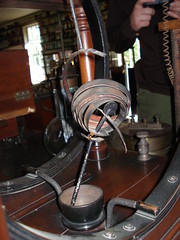
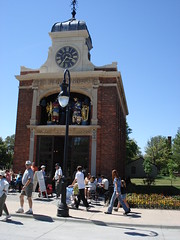

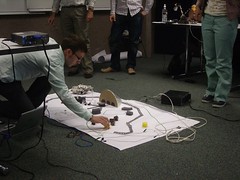
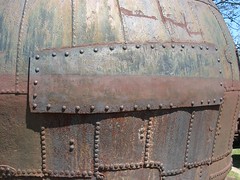
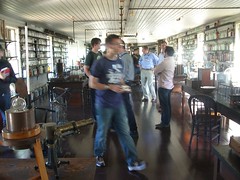
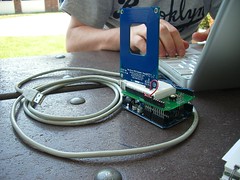




Dear Mike Kuniavsky,
I'm really interested in "Sketching in Hardware." I'm the team leader of the Gainer development team. Gainer is yet another prototyping toolkit for designers and artists.
http://gainer.cc/Main/HomePage?userlang=en
Do you have a plan to hold the conference this year? If possible, I'd like to attend the conference.
I'm sorry for trouble you, but it would be much appreciated if you give me a reply about this issue.
Best regards,
Shigeru Kobayashi